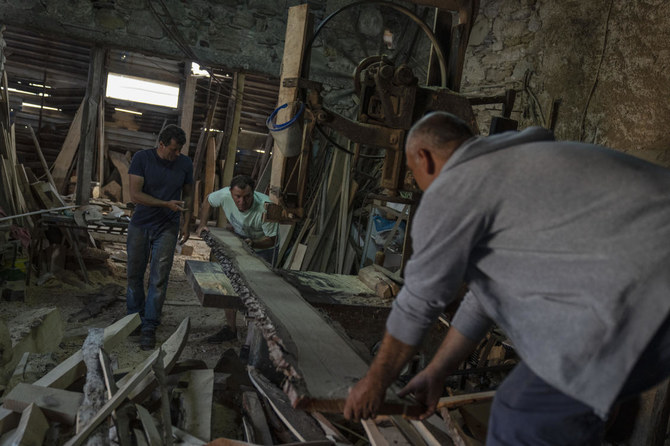DRAKAIOI, Greece: On the forested slopes of an island mountain, early morning mist swirling around its peak, the unmistakable form of a traditional Greek wooden boat emerges: a caique, or kaiki, the likes of which has sailed these seas for hundreds of years.
Each beam of wood, each plank, has been felled, trimmed and shaped by one man alone, hauled and nailed into place using techniques handed down through generations, from father to son, uncle to nephew. But the current generation could be the last.
Wooden boats are an integral part of the Greek landscape, adorning tourist brochures, postcards and countless holiday snaps. They have been sailing across Greece for centuries, used as fishing boats, to transport cargo, livestock and passengers and as pleasure craft.
But the art of designing and building these vessels, done entirely by hand, is under threat. Fewer people order wooden boats since plastic and fiberglass ones are cheaper to maintain. And young people aren’t as interested in joining a profession that requires years of apprenticeship, is physically and mentally draining and has an uncertain future.
“Unfortunately, I see the profession slowly dying,” said Giorgos Kiassos, one of the last remaining boatbuilders on Samos, an eastern Aegean island that was once a major production center.
“If something doesn’t change, there will come a time when there won’t be anyone left doing this type of job. And it’s a pity, a real pity,” Kiassos said during a brief break in his mountain boatyard where, between walnut and wild mulberry trees, he is working on two: a 14-meter (45-foot) pleasure craft and a 10-meter (about a 30-foot) fishing boat.
The boats are being made to order, with the bigger one costing around 60,000 euros ($70,000), and the smaller one around 30,000 euros ($35,000).
Samos caiques are famed both for their workmanship and their raw material: timber from a pine species whose high resin content makes it durable and more resistant to woodworm. A few decades ago, numerous boatyards dotted the island, providing a major source of employment and sustaining entire communities. Now there are only about four left.
“Yes, it’s an art, but it’s also heavy work, it’s tough work. It’s manual labor that’s tiring, and now the young people, none of them are following,” Kiassos said. He’s encouraged his 23-year-old son to learn, but he isn’t particularly interested. He hopes to become a merchant captain instead.
Kostas Damianidis, an architect with a Ph.D. on Greek traditional boatbuilding, said there are several reasons for the dramatic decline in shipwrights, or traditional boatbuilders, throughout Greece.
“It is a traditional craft which is slowly dying, and yet it’s treated as if it were a simple manufacturing or supply business. There is no support from the state,” he said.
What’s more, for years the European Union, of which Greece is a member, has subsidized the physical destruction of these vessels as a way of reducing the country’s fishing fleet. The practice has led to thousands of traditional fishing boats, some described by conservationists as unique works of art, being smashed by bulldozers.
The policy is “a big blow to wooden shipbuilding,” Damianidis said. “They might be old boats, but this is a disdain of the craft. When a young person sees that they’re smashing wooden boats as useless things, why should they bother to learn how to make them?”
For their creators, the destruction is heartbreaking.
“It’s a bad thing, very bad. Because this art is one of the best and one of the most difficult. An ancient art,” retired boatbuilder Giorgos Tsinidelos said. Now 75, he started working at the age of 12 at his grandfather’s boatyard on Samos. He spent years as an apprentice before moving to the major shipbuilding area of Perama, near Greece’s main port of Piraeus.
“You don’t learn this job in a year or two. It takes many years,” he said. “Don’t forget that you take wood and you create a masterpiece, a boat.”
Another major factor in the rapidly dwindling number of shipwrights is the lack of any formal education.
“Young people have to go learn beside the old craftsmen, often for five years, six years, for them to be able to make a small boat, a kaiki, themselves,” Damianidis said. “There is no boatbuilding school.”
Damianidis is the curator of a new museum of Aegean Boatbuilding and Maritime Crafts being set up on Samos, and hopes a traditional boatbuilding school, which would be Greece’s first, will open in the museum.
That could also help Samos’ last boatbuilders, who now work mainly alone due to a shortage of skilled assistants.
“It’s important to have someone experienced because if you make one mistake, especially in the first stages of (building) the boat, the boat might end up being — well, more of a basin than a boat,” chuckled Kiassos.
Like Tsinidelos and all the current boatbuilders, Kiassos started young. Now 47, he’s been working for more than 30 years but says he’s still learning. As a schoolboy, he would sit in his uncle’s boatyard, watching logs morph into beautiful vessels. He began working there at 16 while finishing school.
He learned when the right season is to fell the trees — when to use naturally curved timber, and where on the boat each piece should go. Get that wrong, and the vessel could end up with problems, he explains. Get it right, and his creation combines beauty, function and durability.
The time and effort that goes into production means boatbuilders often form a bond with their creations, and eventually delivering them to their owners is often bittersweet.
Kiassos says he’s eager to finish each boat and start on the next.
“But when it leaves, I’m somehow sad. Yes, I’ll be happy when I see it in the water and I see everything is OK, but it’s like something is leaving — like a piece of me, how can I say it?” He grasps for words. “It might sound a bit strange the way I’m saying it, but that’s how it is.”
Despite the bleak outlook for his profession’s future, another Samos boatbuilder, 45-year-old Andreas Karamanolis, remains hopeful.
“I believe that people will return to the wooden boat. I want to believe it. Because the truth is, no other boat has the durability of the wooden boat. Not the plastic ones, not any of them,” he said. “Wood is a living organism, which no matter how many years you use it, it continues to be alive.”
Greek traditional wooden boat builders a dwindling craft
https://arab.news/5fb97
Greek traditional wooden boat builders a dwindling craft

- The time and effort that goes into production means boatbuilders often form a bond with their creations
A 98-year-old in Ukraine walked miles to safety from Russians, with slippers and a cane

- Describing her journey, the nonagenarian said she had fallen twice and was forced to stop to rest at some points, even sleeping along the way before waking up and continuing her journey
KYIV, Ukraine: A 98-year-old woman in Ukraine who escaped Russian-occupied territory by walking almost 10 kilometers (6 miles) alone, wearing a pair of slippers and supported by a cane has been reunited with her family days after they were separated while fleeing to safety.
Lidia Stepanivna Lomikovska and her family decided to leave the frontline town of Ocheretyne, in the eastern Donetsk region, last week after Russian troops entered it and fighting intensified.
Russians have been advancing in the area, pounding Kyiv’s depleted, ammunition-deprived forces with artillery, drones and bombs.
“I woke up surrounded by shooting all around — so scary,” Lomikovska said in a video interview posted by the National Police of Donetsk region.
In the chaos of the departure, Lomikovska became separated from her son and two daughters-in-law, including one, Olha Lomikovska, injured by shrapnel days earlier. The younger family members took to back routes, but Lydia wanted to stay on the main road.
With a cane in one hand and steadying herself using a splintered piece of wood in the other, the pensioner walked all day without food and water to reach Ukrainian lines.
Describing her journey, the nonagenarian said she had fallen twice and was forced to stop to rest at some points, even sleeping along the way before waking up and continuing her journey.
“Once I lost balance and fell into weeds. I fell asleep … a little, and continued walking. And then, for the second time, again, I fell. But then I got up and thought to myself: “I need to keep walking, bit by bit,’” Lomikovska said.
Pavlo Diachenko, acting spokesman for the National Police of Ukraine in the Donetsk region, said Lomikovska was saved when Ukrainian soldiers spotted her walking along the road in the evening. They handed her over to the “White Angels,” a police group that evacuates citizens living on the front line, who then took her to a shelter for evacuees and contacted her relatives.
“I survived that war,’ she said referring to World War II. “I had to go through this war too, and in the end, I am left with nothing.
“That war wasn’t like this one. I saw that war. Not a single house burned down. But now – everything is on fire,” she said to her rescuer.
In the latest twist to the story, the chief executive of one of Ukraine’s largest banks announced on his Telegram channel Tuesday that the bank would purchase a house for the pensioner.
“Monobank will buy Lydia Stepanivna a house and she will surely live in it until the moment when this abomination disappears from our land,” Oleh Horokhovskyi said.
Amazon Purr-rime: Cat accidentally shipped to online retailer

- Galena was found safe by a warehouse worker at an Amazon center after vanishing from her home in Utah
LOS ANGELES: A curious cat that sneaked into an open box was shipped across the United States to an Amazon warehouse after its unknowing owners sealed it inside.
Carrie Clark’s pet, Galena, vanished from her Utah home on April 10, sparking a furious search that involved plastering “missing” posters around the neighborhood.
But a week later, a vet hundreds of miles (kilometers) away in Los Angeles got in touch to say the cat had been discovered in a box — alongside several pairs of boots — by a warehouse worker at an Amazon center.
“I ran to tell my husband that Galena was found and we broke down upon realizing that she must have jumped into an oversized box that we shipped out the previous Wednesday,” Clark told KSL TV in Salt Lake City.
“The box was a ‘try before you buy,’ and filled with steel-toed work boots.”
Clark and her husband jetted to Los Angeles, where they discovered Amazon employee Brandy Hunter had rescued Galena — a little hungry and thirsty after six days in a cardboard box, but otherwise unharmed.
“I could tell she belonged to someone by the way she was behaving,” said Hunter, according to Amazon.
“I took her home that night and went to the vet the next day to have her checked for a microchip, and the rest is history.”
What did people eat before agriculture? New study offers insight

- Analysis of forms — or isotopes — of elements including carbon, nitrogen, zinc, sulfur and strontium in these remains indicated the type and amount of plants and meat they ate
WASHINGTON: The advent of agriculture roughly 11,500 years ago in the Middle East was a milestone for humankind — a revolution in diet and lifestyle that moved beyond the way hunter-gatherers had existed since Homo sapiens arose more than 300,000 years ago in Africa.
While the scarcity of well-preserved human remains from the period preceding this turning point has made the diet of pre-agricultural people a bit of a mystery, new research is now providing insight into this question. Scientists reconstructed the dietary practices of one such culture from North Africa, surprisingly documenting a heavily plant-based diet.
The researchers examined chemical signatures in bones and teeth from the remains of seven people, as well as various isolated teeth, from about 15,000 years ago found in a cave outside the village of Taforalt in northeastern Morocco. The people were part of what is called the Iberomaurusian culture.
Analysis of forms — or isotopes — of elements including carbon, nitrogen, zinc, sulfur and strontium in these remains indicated the type and amount of plants and meat they ate. Found at the site were remains from different edible wild plants including sweet acorns, pine nuts, pistachio, oats and legumes called pulses. The main prey, based on bones discovered at the cave, was a species called Barbary sheep.
“The prevailing notion has been that hunter-gatherers’ diets were primarily composed of animal proteins. However, the evidence from Taforalt demonstrates that plants constituted a big part of the hunter-gatherers’ menu,” said Zineb Moubtahij, a doctoral student in archaeology at the Max Planck Institute for Evolutionary Anthropology in Germany and lead author of the study published on Monday in the journal Nature Ecology & Evolution.
“It is important as it suggests that possibly several populations in the world already started to include substantial amount of plants in their diet” in the period before agriculture was developed, added archeogeochemist and study co-author Klervia Jaouen of the French research agency CNRS.
The Iberomaurusians were hunter-gatherers who inhabited parts of Morocco and Libya from around 25,000 to 11,000 years ago. Evidence indicates the cave served as a living space and burial site.
These people used the cave for significant portions of each year, suggesting a lifestyle more sedentary than simply roaming the landscape searching for resources, the researchers said. They exploited wild plants that ripened at different seasons of the year, while their dental cavities illustrated a reliance on starchy botanical species.
Edible plants may have been stored by the hunter-gatherers year-round to guard against seasonal shortages of prey and ensure a regular food supply, the researchers said.
These people ate only wild plants, the researchers found. The Iberomaurusians never developed agriculture, which came relatively late to North Africa.
“Interestingly, our findings showed minimal evidence of seafood or freshwater food consumption among these ancient groups. Additionally, it seems that these humans may have introduced wild plants into the diets of their infants at an earlier stage than previously believed,” Moubtahij said.
“Specifically, we focused on the transition from breastfeeding to solid foods in infants. Breast milk has a unique isotopic signature, distinct from the isotopic composition of solid foods typically consumed by adults.”
Two infants were among the seven people whose remains were studied. By comparing the chemical composition of an infant’s tooth, formed during the breastfeeding period, with the composition of bone tissue, which reflects the diet shortly before death, the researchers discerned changes in the baby’s diet over time. The evidence indicated the introduction of solid foods at around the age of 12 months, with babies weaned earlier than expected for a pre-agricultural society.
North Africa is a key region for studying Homo sapiens evolution and dispersal out of Africa.
“Understanding why some hunter-gatherer groups transitioned to agriculture while others did not can provide valuable insights into the drivers of agricultural innovation and the factors that influenced human societies’ decisions to adopt new subsistence strategies,” Moubtahij said.
Palestinian prisoner in Israel wins top fiction prize

- The mask in the novel’s title refers to the blue identity card that Nur, an archaeologist living in a refugee camp in Ramallah, finds in the pocket of an old coat belonging to an Israeli
ABU DHABI: Palestinian writer Basim Khandaqji, jailed 20 years ago in Israel, won a prestigious prize for Arabic fiction on Sunday for his novel “A Mask, the Color of the Sky.”
The award of the 2024 International Prize for Arabic Fiction was announced at a ceremony in Abu Dhabi.
The prize was accepted on Khandaqji’s behalf by Rana Idriss, owner of Dar Al-Adab, the book’s Lebanon-based publisher.
Khandaqji was born in the Israeli-occupied West Bank city of Nablus in 1983, and wrote short stories until his arrest in 2004 at the age of 21.
He was convicted and jailed on charges relating to a deadly bombing in Tel Aviv, and completed his university education from inside jail via the Internet.
The mask in the novel’s title refers to the blue identity card that Nur, an archaeologist living in a refugee camp in Ramallah, finds in the pocket of an old coat belonging to an Israeli.
Khandaqji’s book was chosen from 133 works submitted to the competition.
Nabil Suleiman, who chaired the jury, said the novel “dissects a complex, bitter reality of family fragmentation, displacement, genocide, and racism.”
Since being jailed Khandaqji has written poetry collections including “Rituals of the First Time” and “The Breath of a Nocturnal Poem.”
He has also written three earlier novels.
Mexican doctor claims victory in $28 Cartier earrings battle

MEXICO CITY: A Mexican man has claimed a victory over French luxury brand Cartier, saying an error allowed him to buy two pairs of earrings for $28 that were supposed to cost nearly $28,000.
After a four-month struggle, doctor Rogelio Villarreal said he had finally received the jewelry, which he accused the company of refusing to deliver after his online purchase in December.
According to Villarreal, he came across the low-priced earrings while browsing Instagram.
“I swear I broke out in a cold sweat,” he wrote on the social media platform X.
Cartier declined to recognize the purchase and offered Villarreal a refund, as well as a bottle of champagne and a passport holder as compensation, according to a company letter shared by the doctor.
But Villarreal refused and decided to take the case to Mexico’s consumer protection agency, which ruled in favor of the doctor.
Cartier accepted the decision, Villarreal announced.
“War is over. Cartier is complying,” he wrote.


















